|
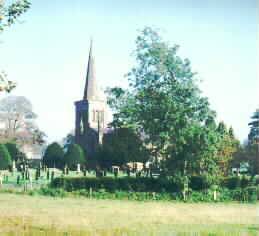
|
|
Christ Church, Hilderstone, was built on the
initiative of the local squire, Ralph Bourne. Mr. Bourne was able
to persuade the first Earl of Harrowby, who was a Church
Commissioner, to support the founding of the church.
The
building was partially funded by the Church Commissioners and so
is one of many known as Commissioners Churches or Waterloo
Churches. The reference to Waterloo arises from the grant of £1,000,000
made to the Church Commissioners to assist with church building as
a thanksgiving for the success of the British in the battle of
Waterloo.
The
designs of Commissioners Churches had to be approved by the
Commissioners and they were keen to ensure that the maximum of
space for worship was attained for the money expended on the
churches supported by them. As a result of this requirement and
the liturgy of the time such churches prior to 1835 have a
rectangular nave with one shallow sanctuary. The were usually
plain and functional. The seat all face towards the sanctuary
which is not obscured by the reading desk or pulpit.
This
style of church architecture was not popular with the Victorians
who, in response to changes in churchmanship and with new found
wealth, set about modifying Commissioners churches. Thus by the
end of the nineteenth century most Commissioners Churches had
acquired a chancel, an organ had been installed in the East end
and one or more galleries removed. The plain obscured glass in the
windows in the south and north walls had been replaced by stained
glass of variable quality.
Christ
Church, Hilderstone, is believed to be the only rural
Commissioners Church which is almost untouched since its
construction. It is through this good fortune that the Concerts in
Christ Church, Hilderstone, has such a lovely venue for its
performances. The West Gallery Quire, known as the John
Moore Quire have given a concert here.
|
|
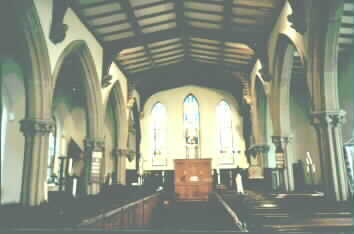
The interior of
Christ Church, as it is today.
|
|
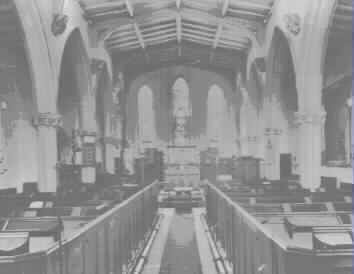
and as it was in
1953
|
|
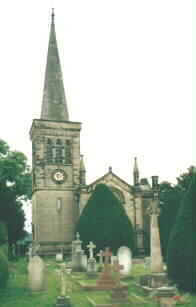
|
|
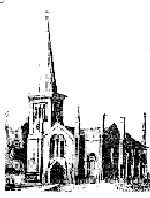
Christ Church,
Hilderstone from a drawing of the 1830s. It is
surprising how little has changed today. Compare with
the photograph above.
|
|
The
church has a low tower with a spire 40 feet tall. The tower has
one bell, which is tolled each Sunday. The interior of the
church is 72 feet long and 32 feet wide. Christ Church has a
central aisle and two side aisles. The gargoyles on the outside
of the building are said to depict the workmen involved in the
construction of the church and, generally speaking, are in
excellent condition. The corbels inside are representations of
the founder, the first incumbent and the architect.
Christ
Church, Hilderstone was built with the aid of funds made
available under the Church Building Acts, the first of which was
in 1818. Churches built with the assistance of those funds are
known as "Commissioners churches", or "Waterloo
churches", since the Church Building Act 1818 was passed in
part to commemorate the success in the Battle of Waterloo. Other
reasons for the Acts were said to be an attempt to stem the tide
of Dissent and bringing the established church to those who were
not served by Church of England churches, often those affected
by industrialization or living in small poorer villages.
The
Lords Commissioner of the Treasury, administered the monies
provided under the Acts to assist the building of Commissionersí
churches. The churches built using their funds had to represent
good value for money. They were to be built "with a view to
accommodating the greatest number of persons at the smallest
expense within the compass of an ordinary voice, one half of the
number to be free seats for the poor".
|
|
The Commissioners laid down specific
stipulations as to design and personally approved the pans of all
churches funded by them. Examples of requirements are "the windows
ought not to resemble modern sashes; but whether Grecian or Gothic,
should be in small panes and not costly" and "The pulpit
should not intercept a view of the altar, but all seats should be placed
so as to face the preacher". The application of these requirements
can be seen in Christ Church, Hilderstone. Commissionerís churches
(and others built at the same time) have characteristic features. They
have lean proportions. A large rectangle with the altar at the end set
in a short chancel. There is often a pulpit on one side of the chancel,
with a reading desk at a lower level on the other. The organ is in a
West gallery. Beneath the West gallery is the font. Windows were long
and pointed. Often they have lancet windows with shallow buttresses
between. Each of these features may been seen in Christ Church.
The
Victorians did not favour Commissioners churches. They regarded them as
cheap and unworthy. The design and structure of Commissioners churches
did not lie easily with developments in the Anglican liturgy and
theology in Victorian England. Victorian architects despoiled the vast
majority of them. Betjeman says (in the Collins Guide to Parish
Churches of England and Wales, London 1980, p 61) that he is aware
of only one Commissioners church which has survived exactly as its
architect designed it. He refers to Christ Church, Acton Square,
Salford. Christ Church, Hilderstone, is another. Good fortune, and a
lack of funds, has meant that Christ Church Hilderstone is very much as
Thomas Trubshaw designed it. There have been only minor changes to the
furnishings. Although the building has been lit by electricity since
1947, the original candlesticks are in place at the pew ends!
|
|
In his "Buildings
of England: Staffordshire", Sir Nikolaus Pevsner says
"Christ Church
(1827-29) by Thomas Trubshaw. Commissionersí type, but with a
North West steeple carrying a recessed spire. The church has
lancets, with flattish buttresses between, and typically clumsy
pinnacles. The interior has originality - ignorance breeding
originality - with its octagonal piers, each side carrying fluting
or a sunken panel, and its leaf capitals. Angel corbels for the
roof inform us of the people connected with the new building
(Ralph Bourne, the donor, the parson at the time, and the
architect). Box Pews. Stained Glass. The east window with its
glaring colours typical of its date: 1829 by Collins of London (CPDD)."
Pevsner is unduly
harsh. The charm of the church arises from the fact that it is a
local work, little changed from the time when it was first built.
|
|
|

|
|
|

|
|
|
|
|
SEARCH THIS SITE |
|
|
This
site has been constructed by, and remains the copyright of,
its authors,
Edwin and Sheila Macadam,
Shelwin, 30, Eynsham Road, Botley,
Oxford OX2 9BP
|
|
| ©
July 2001 -
|
|